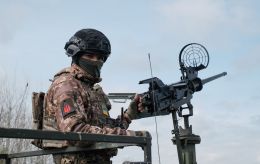How Ukraine's defense forces break the patterns of war
 The Ukrainian defense forces successfully resist Russia without having a numerical advantage (photo: Facebook of the Ministry of Defense of Ukraine)
The Ukrainian defense forces successfully resist Russia without having a numerical advantage (photo: Facebook of the Ministry of Defense of Ukraine)
Military and political expert of the Information Resistance group, Oleksandr Kovalenko, shares his insights with RBC-Ukraine on the peculiarities of the actions of the Ukrainian army and how it operates contrary to the general norms.
The war in Ukraine is unique because it has broken the common patterns for conducting military operations. The most striking example is that the Ukrainian Defense Forces are currently advancing in the Zaporizhzhia region. According to all the canons of warfare, an offensive should be conducted with significantly greater forces than those defending. Currently, the Russians in the Azov region have over 100,000 personnel (referring to the East Group of Troops). This is at least three times more than the strength of the Ukrainian Defense Forces units involved in the offensive.
Furthermore, the Russians have hyper-fortified defense lines in the south. For instance, the enemy's first line of defense has an extraordinarily high number of minefields. Yet, we have breached it within fairly standard time frames, advancing 100-200 meters daily. Hence, it's a unique case – we are advancing with far fewer forces, in an extremely challenging zone, and we are successfully breaking through the enemy's defense lines.
Another example is the situation in the Black Sea. It's a unique case where a country without a fleet defeats a country with a fleet in a naval battle. Despite Russia having a powerful fleet, we are winning at sea using drones and other means of attack. Consequently, Russia incurs much greater losses than Ukraine.
It's unlikely that we can call it unique that a country with more human, technical, and economic resources invaded Ukraine and failed to achieve any of its military objectives. There have been instances in history when smaller states held their ground against larger adversaries, such as the Winter War in Finland. However, the scale of military operations in Ukraine has long surpassed it in terms of magnitude. Ultimately, even on February 24, 2022, international partners were not confident in our ability to withstand. Therefore, this can also be considered a disruption of norms.
Another interesting aspect: Ukraine, without physically being on Russian territory, destroys its transport and strategic aviation, missile carriers, and bombers, including Il-76, Tu-22M3, and Tu-95MS. Moreover, this influence extends deep into the enemy's territory, not with missiles but with entirely different means.
Another peculiarity of today's war is the extensive use of drones, from both sides. The most active use of drones was seen during the Second Karabakh War. Azerbaijani forces frequently used drone swarms, drones, and reconnaissance UAVs. They essentially controlled the skies over Karabakh. However, when compared to the war in Ukraine, it's an entirely different level.
Currently, the world is witnessing how the use of drones affects maritime warfare and how large ships can be targeted. Until now, only Iran had used similar drones in conflicts, including in the Strait of Hormuz. However, it involved a simple boat loaded with explosives and manned by a pilot. It was directed toward an enemy ship, and the pilot would bail out before impact and head for the shore.
Furthermore, everyone talks about aerial and maritime drones, but Ukraine also has ground drones that, for example, conduct mine-laying operations. Such a drone enters an area that is under enemy fire and installs minefields. It moves almost at ground level and remains unnoticed by the enemy. Therefore, we are comprehensive in our use of drones.
Additionally, there hasn't been such an overload of air defense systems in modern wars and conflicts, both on the defensive and offensive sides. This means that not only Ukraine but also Russia now has to keep its air defense assets on constant alert. Various algorithms are used to counter missile weapons and drones. In the modern history of wars and conflicts, there has been no such massive engagement of air defense.

